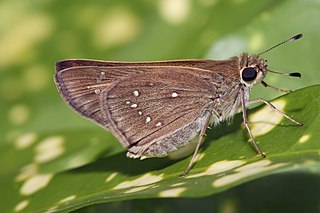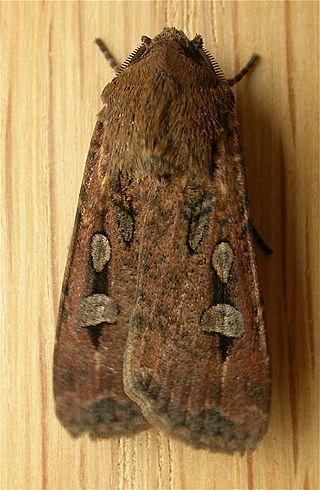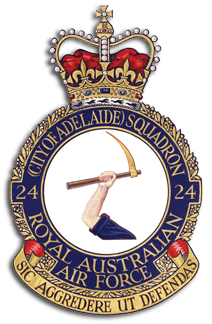
Moths are a paraphyletic group of insects that includes all members of the order Lepidoptera that are not butterflies, with moths making up the vast majority of the order. There are thought to be approximately 160,000 species of moth, many of which have yet to be described. Most species of moth are nocturnal, but there are also crepuscular and diurnal species.

The de Havilland Aircraft Company Limited was a British aviation manufacturer established in late 1920 by Geoffrey de Havilland at Stag Lane Aerodrome Edgware on the outskirts of north London. Operations were later moved to Hatfield in Hertfordshire.

Skippers are a family of the Lepidoptera named the Hesperiidae. Being diurnal, they are generally called butterflies. They were previously placed in a separate superfamily, Hesperioidea; however, the most recent taxonomy places the family in the superfamily Papilionoidea, the butterflies. They are named for their quick, darting flight habits. Most have their antenna tips modified into narrow, hook-like projections. Moreover, skippers mostly have an absence of wing-coupling structure available in most moths. More than 3500 species of skippers are recognized, and they occur worldwide, but with the greatest diversity in the Neotropical regions of Central and South America.

The de Havilland DH.82 Tiger Moth is a 1930s British biplane designed by Geoffrey de Havilland and built by the de Havilland Aircraft Company. It was operated by the Royal Air Force (RAF) and other operators as a primary trainer aircraft. In addition to the type's principal use for ab initio training, the Second World War had RAF Tiger Moths operating in other capacities, including maritime surveillance and defensive anti-invasion preparations; some aircraft were even outfitted to function as armed light bombers.

The Pterophoridae or plume moths are a family of Lepidoptera with unusually modified wings. Though they belong to the Apoditrysia like the larger moths and the butterflies, unlike these they are tiny and were formerly included among the assemblage called "microlepidoptera".

The Gelechiidae are a family of moths commonly referred to as twirler moths or gelechiid moths. They are the namesake family of the huge and little-studied superfamily Gelechioidea, and the family's taxonomy has been subject to considerable dispute. These are generally very small moths with narrow, fringed wings. The larvae of most species feed internally on various parts of their host plants, sometimes causing galls. Douglas-fir (Pseudotsuga) is a host plant common to many species of the family, particularly of the genus Chionodes, which as a result is more diverse in North America than usual for Gelechioidea.

Jane Gardner Batten, commonly known as Jean Batten, was a New Zealand aviator, making a number of record-breaking solo flights across the world. She is notable for completing the first solo flight from England to New Zealand in 1936.

The bogong moth is a temperate species of night-flying moth, notable for its biannual long-distance seasonal migrations towards and from the Australian Alps, similar to the diurnal monarch butterfly. During the autumn and winter it is found in southern Queensland, western New South Wales, western Victoria, and also in South and Western Australia. Adult bogong moths breed and larvae hatch during this period, consuming winter pasture plants during their growth. During the spring, the moths migrate south or east and reside in mountains such as Mount Bogong, where they gregariously aestivate over the summer until their return towards breeding grounds again in the autumn.

The de Havilland DH.80A Puss Moth is a British three-seater high-wing monoplane aeroplane designed and built by the de Havilland Aircraft Company between 1929 and 1933. It flew at a speed approaching 124 mph (200 km/h), making it one of the highest-performance private aircraft of its era.

Castniidae, or castniid moths, is a small family of moths with fewer than 200 species: The majority are Neotropical with some in Australia and a few in south-east Asia. These are medium-sized to very large moths, usually with drab, cryptically-marked forewings and brightly coloured hindwings. They have clubbed antennae and are day flying, and are often mistaken for butterflies. Indeed, some previous classification systems placed this family within the butterflies or skippers. The Neotropical species are commonly known as giant butterfly-moths, the Australian and Asian species as sun moths. The larvae are internal feeders, often on roots of epiphytes or on monocotyledons.

No. 24 Squadron is a Royal Australian Air Force squadron. The squadron was formed in 1940 and saw action as a bomber squadron during World War II serving in the Pacific theatre against the Japanese, and undertaking operations during the Battle of Rabaul, and the New Guinea, New Britain and Borneo campaigns. The squadron was disbanded in 1946 following the conclusion of hostilities, but was re-formed in 1951. From then until 2010 the squadron was an RAAF Reserve squadron located near Adelaide, South Australia; for part of this time, until 1960, the squadron continued to perform flying duties, before converting to a ground support role. In 2010, the squadron combined with Combat Support Unit Edinburgh to become a Permanent Air Force unit and it currently forms part of No. 96 Wing, Combat Support Group.

The Moth is a small development class of sailing dinghy. Originally a small, fast home-built sailing boat designed to plane, since 2000 it has become an expensive and largely commercially-produced boat designed to hydroplane on foils though many are still built at home, typically at much lower cost.
No. 23 Squadron of the Royal Australian Air Force (RAAF) is a non-flying base operations and training squadron headquartered at RAAF Base Amberley near Brisbane, Queensland. The squadron was formed in 1937 and saw action against the Japanese during World War II as a bomber squadron. Operating from Archerfield during the early stages of the war, the squadron undertook maritime patrols off Australia's east coast before converting to a dive-bomber role and taking part in the New Guinea campaign. Later in the war, the squadron converted to Liberator heavy bombers and flew missions against Japanese targets in the Netherlands East Indies. After the war, No. 23 Squadron was used to reform No. 6 Squadron and was then re-raised as a Citizens Air Force unit based in Brisbane. Until 1960, the squadron flew jet fighter aircraft before converting to a ground support role and now forms part of the RAAF's Combat Support Group.

The de Havilland DH.60 Moth is a 1920s British two-seat touring and training aircraft that was developed into a series of aircraft by the de Havilland Aircraft Company.

No. 35 Squadron is a Royal Australian Air Force (RAAF) transport unit. Formed in 1942, No. 35 Squadron operated during World War II, transporting cargo and passengers around Australia, New Guinea and the Netherlands East Indies, equipped with a variety of aircraft including the Douglas Dakota. It was disbanded after the war, but was re-raised in the 1960s for service during the Vietnam War, flying transportation and resupply operations with DHC-4 Caribous in support of Australian and US forces. The squadron was subsequently augmented with rotary-wing aircraft, operating UH-1 Iroquois in both the transportation and gunship roles. In the late 1980s, the squadron returned to a solely fixed-wing transport role. It ceased operations in 2000, but was re-raised in January 2013. It began re-equipping with C-27 Spartan transports in 2015.

Nepticulidae is a family of very small moths with a worldwide distribution. They are characterised by eyecaps over the eyes. These pigmy moths or midget moths, as they are commonly known, include the smallest of all living moths, with a wingspan that can be as little as 3 mm in the case of the European pigmy sorrel moth, but more usually 3.5–10 mm. The wings of adult moths are narrow and lanceolate, sometimes with metallic markings, and with the venation very simplified compared to most other moths.
The Cosmopterigidae are a family of insects in the order Lepidoptera. These are small moths with narrow wings whose tiny larvae feed internally on the leaves, seeds and stems of their host plants. About 1500 species are described. The taxonomic family is most diverse in the Australian and Pacific region with about 780 species.
The Queanbeyan Nature Reserve is a protected nature reserve that is located in the Southern Tablelands region of New South Wales, in eastern Australia. The 67-hectare (170-acre) reserve is situated approximately 4 kilometres (2.5 mi) west-south-west of the City of Queanbeyan.














